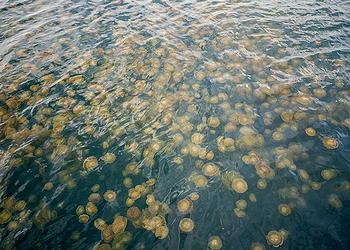
ROME, Italy, May 30, 2013 (ENS) – Jumps in jellyfish populations following overfishing is one reason why fish in the Mediterranean and Black seas are declining, finds a new United Nations report that advocates factoring jellyfish “blooms” into fisheries management strategies.

Overfishing removes top predators from the sea, helping to create ideal conditions for jellyfish blooms, according to the report, “Review of Jellyfish Blooms in the Mediterranean and Black Sea,” published by the UN Food and Agriculture Organization’s General Fisheries Commission for the Mediterranean.
“It is clear that a new type of human approach to marine ecosystems in general is needed to prevent and face a phenomenon such as the jellyfish blooms,” writes the report’s author, Ferdinando Boero.
A zoologist and marine biologist, Professor Boero heads the Laboratory of Zoology and Marine Biology at the University of Salento in Lecce, Italy. He serves as scientific coordinator of the Environment Museum of the university and as editor in chief of the Italian “Journal of Zoology.”
Boero first came to international attention in 1983 when he named a newly discovered jellyfish species Phialella zappai after Frank Zappa in order to get the chance to meet the musician. Zappa famously said, “There is nothing I would like better than having a jellyfish with my name.”
In the FAO report Boero describes how an increased number of jellyfish in the waters creates a “vicious cycle” where the jellyfish increasingly prey on fish eggs and larvae, and compete for the same food source as the fish populations already depleted by overfishing.

If the trend continues, jellyfish could supplant fish in the world’s oceans, according to experts cited in the report who write of “a global regime shift from a fish to a jellyfish ocean.”
In addition to overfishing, Boero notes the impact of global warming which enables the species that thrive at tropical latitudes to increase their range, and the prevalent use of sea walls, built to prevent coastal erosion, which are ideal habitats for some jellyfish species.
“Overall, overfishing and global warming are probably the most important drivers of increased jellyfish presence in the global ocean and, with due exceptions, also in the Mediterranean and the Black Sea,” writes Boero.
“Gelatinous plankton is formed by representatives of Cnidaria (true jellyfish), Ctenophora (comb jellies) and Tunicata (salps),” writes Boero. “The life cycles of gelatinous plankters are conducive to bloom events, with huge populations that are occasionally built up whenever conditions are favorable. Such events have been known since ancient times and are part of the normal functioning of the oceans.”
“In the last decade, however, the media are reporting on an increasingly high number of gelatinous plankton blooms,” he writes in the report. “The reasons for these reports is that thousands of tourists are stung, fisheries are harmed or even impaired by jellyfish that eat fish eggs and larvae, coastal plants are stopped by gelatinous masses.”
Power plants and other industries on coastlines can suck masses of jellyfish into their intake water pumps. The presence of jellyfish forces the plants to stop functioning to clear their pipes, a problem that has affected facilities in Japan, Philippines, China, India, Baltic Sea, Gulf of Oman, Qatar, the Arabian [or Persian] Gulf, and the United States.

The impact of jellyfish was demonstrated in the early 1980s when Mnemiopsis leidyi, a jellyfish species known as the “sea walnut” and normally resident in the Atlantic Ocean, was accidentally introduced into the Black Sea and had such “overwhelming” impact on fish populations that fisheries were put “on their knees.”
“This species is typical of the Atlantic coast of the USA, and was probably brought to the Black Sea as a clandestine passenger in the ballast waters of US oil tankers,” Boero writes.
By 1989, the population reached its highest level with some 400 specimens per cubic meter of water or more than 10 animals per cubic foot of water. The jellyfish ate up a commercially important type of anchovy, preying on the larvea and young, as well as on the anchovy’s food source.
The problem was resolved after another invader species, the Beroe ovata, which feeds on Mnemiopsis, also arrived in the Black Sea.
In November 2007, a 10-square-mile (26 km2) swarm of the jellyfish wiped out a 100,000 fish salmon farm in Northern Ireland, causing some US$1.5 million worth of damage.
Among other measures to prevent or cope with jellyfish blooms, the report suggests using jellyfish products for food and medicine.
China is among the first countries to process jellyfish for human consumption, particularly the edible Rhopilema esculentum, and is developing a multi-million-dollar seafood business based on jellyfish.
Other jellyfish, such as the “immortal jellyfish” or Turritopsis nutricula, capable of reversing its aging process, exhibit promise in the field of human aging prevention.
Copyright Environment News Service (ENS) 2013. All rights reserved.
